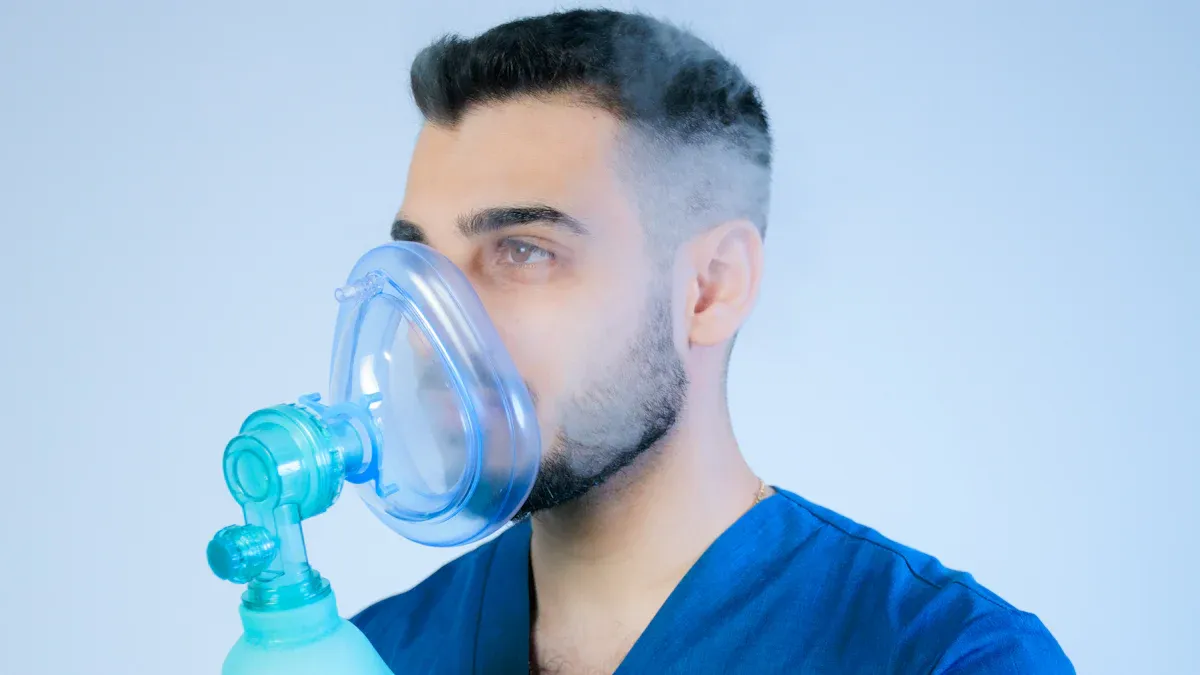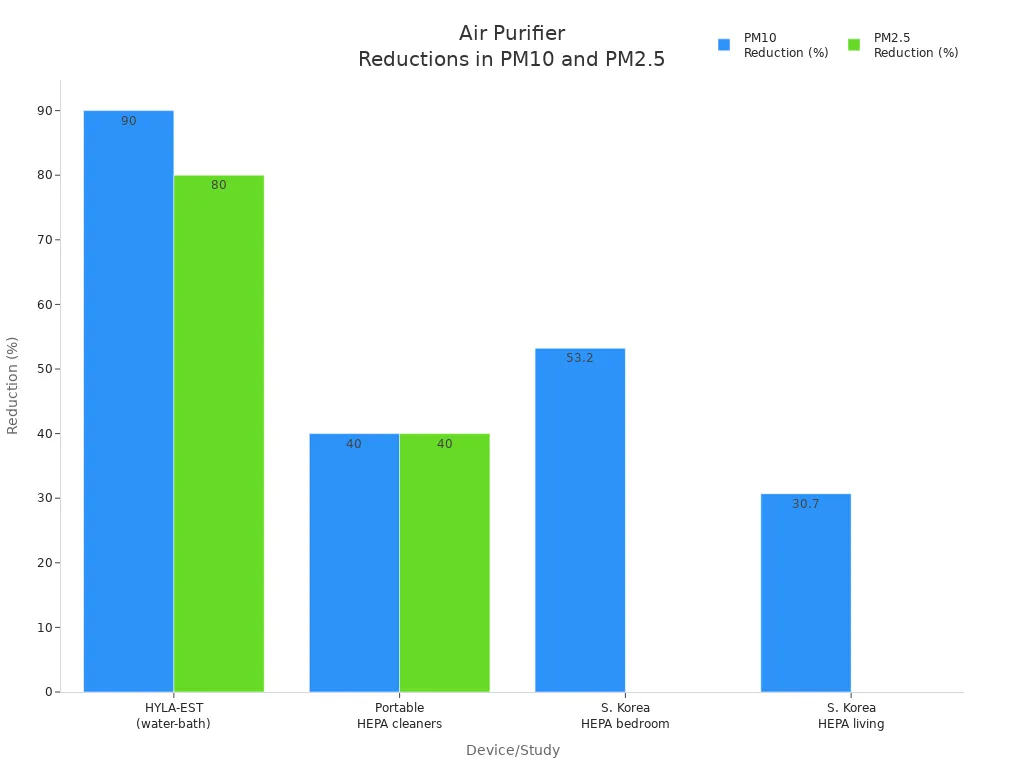
You might ask if an air purifier helps with sinus or allergy symptoms. Studies say these machines can lower dust, pollen, and other things in the air. For example, research showed that HEPA filters made asthma symptoms happen less in kids. They also helped allergy symptoms in both kids and adults. You may have less stuffy nose and breathe easier, especially if your home has bad air. But air purifiers do not fully cure allergies or sinus problems.
Key Takeaways
- Air purifiers with true HEPA filters take out most allergens in the air like dust, pollen, and pet dander. This helps lower allergy and sinus symptoms.
- Using an air purifier can make it easier to breathe. It can also mean you need less allergy medicine. But it does not fully fix allergies or sinus problems.
- For the best results, pick an air purifier with both HEPA and activated carbon filters. This will remove both tiny particles and harmful gases.
- Keep your air purifier clean. Put it in the right spot. Make sure it is the right size for your room. This helps it clean the air well.
- Use air purifiers with regular cleaning, humidity control, and fresh air. This gives you the most help with allergies and sinus problems.
How Air Purifiers Work

Main Technologies
Modern air purifiers use a few main technologies. Each one helps with different indoor pollutants. Here is how the most common ones work:
- HEPA Filters: These filters catch small things like dust, pollen, pet dander, and mold spores. HEPA Filters can trap at least 99.97% of particles that are 0.3 microns or bigger. Some special HEPA Filters, like HEPA 14, can trap up to 99.995% of these particles.
- Ionization: This technology sends ions into the air. The ions stick to tiny particles in the air. The particles then clump together and fall down. This helps lower allergens in your house.
- Activated Carbon: This filter takes away gases, odors, and chemical vapors. It does not catch dust or pollen. It helps with smells and some harmful gases.
- UV-C Light: UV-C targets germs like bacteria and viruses. It destroys their DNA so they cannot hurt you. UV-C does not remove dust or pollen. It must be safely covered so it does not make ozone.
| Technology | Target Pollutants / Functionality |
|---|---|
| HEPA Filter | Captures dust, pollen, pet dander, mold spores (≥99.97% efficiency) |
| Activated Carbon | Removes gases, odors, VOCs; not particles |
| UV-C Technology | Neutralizes germs; not particles; may produce ozone |
Tip: For allergy relief, pick an air purifier with a true HEPA Filter. This kind works best for removing common allergens.
Allergen Removal
You may wonder how well air purifiers get rid of allergens. Studies show that HEPA Filters in air purifiers can lower dust mites, pet dander, and pollen in your home. In one study, air purifiers with HEPA Filters lowered dust mite and pet allergens by 65% to 89%. They work fast, often in just 10 to 15 minutes in a bedroom. Even if you do not have pets, pet allergens can still be in your home. Using an air purifier helps lower your contact with them.
Research also shows that air purifiers can lower allergy symptoms by about 24% to 26%. The American Academy of Allergy, Asthma & Immunology says air filtration helps reduce allergens. But air purifiers do not cure allergies. You still need to clean your home and control humidity. High humidity can make allergens grow. Low humidity can make your nose feel dry. Some air purifiers mix filtration with humidity control for better results.
Air Purifier Benefits

Symptom Relief
When you use an air purifier at home, you might have fewer allergy and sinus problems. Many people say they sneeze less and breathe easier. Some studies show that using a HEPA filter can help you need less allergy medicine. For example, one study found people with dust mite allergies used less medicine after six weeks with an air purifier. But the same study did not see big changes in sneezing or stuffy noses. This means you may still have some symptoms, but you might not need as much medicine.
Note: Air purifiers take out dust, pollen, and other small things from the air. They do not cure allergies or sinus problems, but they can make your symptoms milder.
If you use air purifiers for a long time, you might have fewer allergy attacks and breathe better. You could feel less stressed and be in a better mood because clean air is good for your health. If you have asthma or sinus problems, you may notice your daily life gets easier. Some people even find their lungs work better and they have fewer bad days over time.
Scientific Evidence
Scientists have checked how well air purifiers help with allergy and sinus relief. Here are some key facts:
- Wearable air purifiers can lower allergy symptoms from pollen, dust mites, and pet allergens by up to 60%.
- Portable air purifiers can cut indoor PM2.5 by 22.6% to 92%. This means the air in your house gets much cleaner.
- Some devices, like the Respiray Wear A+, show about 50% to 60% fewer symptoms for people around birch pollen, dust mites, and cat allergens.
- Stationary air purifiers can help stop asthma attacks when you are near allergens. Wearable purifiers let you move around while staying protected.
- Using a wearable air purifier may help you use less allergy medicine during times with lots of pollen.
- Air purifiers work best when you also clean, control humidity, and use other ways to protect yourself.
You can see how much air purifiers lower particles and allergens in different studies:
| Device/Study | PM10 Reduction (%) | PM2.5 Reduction (%) | Allergen Reduction (Endotoxins) |
|---|---|---|---|
| HYLA-EST (water-bath filtration) | ~90 | ~80 | Traps allergens in water |
| Portable HEPA air cleaners | 30-50 | 30-50 | No significant reduction |
| South Korea HEPA trial (bedrooms) | 53.2 | N/A | No significant change |
| South Korea HEPA trial (living rooms) | 30.7 | N/A | No significant change |
You can also look at this chart to see how different air purifiers lower PM10 and PM2.5 levels:

Tip: Air purifiers work best for things floating in the air. They do not get rid of allergens on furniture or carpets. You should also clean your home and keep humidity under control for the best results.
When you compare air purifiers to other tools, you see each one has a special job:
| Intervention | Mechanism of Action | Target Allergens/Triggers | Best Use Case / Notes |
|---|---|---|---|
| Air Purifier | Uses HEPA filters or other technologies to trap airborne particles | Dust, pollen, pet hair, airborne allergens | Good for lowering allergens in the air nearby; does not help with allergens on surfaces |
| Dehumidifier | Removes moisture from air to reduce humidity levels | Mold, mildew, dust mites (moisture-related) | Best for homes with high humidity; helps control moisture allergens; works well with air purifiers |
You can use both an air purifier and a dehumidifier to help with allergies. The air purifier takes out particles from the air. The dehumidifier lowers moisture to stop mold and dust mites.
Note: Scientists agree that air purifiers help lower dust, pollen, mold, and pet dander in the air. This means fewer allergy and sinus problems over time. But research shows mixed results for big changes in symptoms or lung health. You should use air purifiers as part of a full plan to manage allergies and sinus issues.
Types and Effectiveness
HEPA vs. Others
There are different air cleaning technologies. Not all of them help with sinus or allergy problems the same way. HEPA filters are the best for taking allergens out of the air. HEPA H13 filters can trap 99.97% of very tiny particles, even ones as small as 0.01 microns. This means they catch things like dust mites, pollen, pet dander, and germs that can make sinus issues worse.
Some other filters, like activated carbon, only remove gases and bad smells. They do not take out dust or pollen. Electrostatic precipitators and ULPA filters may sound fancy, but they do not work as well at home. ULPA filters can slow down the air, so they are not as good for cleaning your room.
Here is a quick comparison:
| Filter Technology | Efficiency | Particle Size (microns) | Best For | Notes |
|---|---|---|---|---|
| HEPA (H13) | 99.97% | 0.01 | Allergens, fine particles | Industry standard for allergy relief |
| ULPA | >99.999% | 0.12 | Ultra-fine particles | Reduces airflow, less practical at home |
| Activated Carbon | N/A | N/A | Gases, odors, VOCs | Not for dust or pollen |
| Electrostatic Precipitator | N/A | N/A | Some particles | Less reliable, not preferred for allergies |
Clinical guidelines say HEPA filters are the best for allergies and sinus relief. They clean the air well and let air move easily, which helps keep your air fresh.
Best for Sinus Relief
You get the best sinus relief when you use an air purifier with more than one filter. Pick a device that has both a HEPA filter and an activated carbon filter. This way, you remove both tiny allergens and harmful gases that can bother your sinuses.
- Multi-step filtration systems, like Eoleaf’s 8-step technology, clean the air better.
- HEPA H13 filters take out small particles, and activated carbon removes chemical pollutants.
- Clean Air Delivery Rate (CADR) tells you how much air gets cleaned each hour. A higher CADR means the purifier works better.
- Air Changes per Hour (ACH) shows how many times the air in your room is cleaned. Try to get at least 4-5 ACH for strong sinus relief.
- Make sure you pick the right size for your room. For example:
- NeoPur 400 is good for rooms up to 40 m².
- TeraPur 600 fits rooms up to 80 m².
- AltaPur 700 works for rooms up to 120 m².
Tip: If you have sinus symptoms all the time, run your air purifier all day. Smart controls and easy cleaning make it simple to keep your air fresh.
Experts agree that using both HEPA and activated carbon filters gives you the best defense against allergens and pollutants. This matches the newest advice for people with chronic sinusitis or strong allergies.
Limitations
What Air Purifiers Can’t Do
You may think an air purifier can solve all your indoor air problems, but that is not true. These devices have limits. Here are some things they cannot do:
- Remove large particles like dust on furniture, carpets, or curtains. You still need to clean these surfaces.
- Get rid of mold growing on walls or ceilings. Air purifiers only trap mold spores floating in the air. You must fix leaks and clean moldy spots.
- Remove all gases and chemical pollutants. Most standard models, even with HEPA filters, do not catch things like formaldehyde, radon, or strong chemical smells.
- Stop all allergy or asthma symptoms. You may still react to allergens that settle on surfaces or come from outside.
- Replace the need for good ventilation or source control. You need to open windows sometimes and fix sources of pollution.
Some types, like ionizers or ozone generators, can even make things worse. They may produce ozone, which can irritate your lungs and make asthma or allergies worse. Cheap or poorly maintained filters do not work well and may even harm your health.
Note: You should always use an air purifier with other steps like cleaning, fixing leaks, and letting in fresh air.
Factors Affecting Results
How well your air purifier works depends on several things:
- Room size matters. If your room is too big for your device, it will not clean the air well. Always check the Clean Air Delivery Rate (CADR) and match it to your room size.
- Placement is important. Put your unit in the center of the room, away from walls and corners. Keep at least 6-12 inches of space around it for good airflow.
- Maintenance keeps your device working. Change or clean filters as the maker says. Wipe the outside and vacuum the grills to stop dust from building up.
- Humidity affects allergens. High humidity (over 60%) helps mold and dust mites grow. Low humidity (under 30%) dries out your nose and throat. Try to keep indoor humidity between 40-50% for best results.
- Use more than one unit in large or multi-story homes. Place them where you spend the most time, like bedrooms or living rooms.
Keeping your air purifier clean and using it with other tools, like dehumidifiers or humidifiers, gives you the best chance for relief from allergy and sinus symptoms.
Choosing an Air Purifier
Selection Tips
If you want help with allergies or sinus problems, look for certain features in an air purifier. Experts say you should pick one with a true HEPA filter. This filter can catch almost all tiny particles, like pollen, dust mites, pet dander, and mold spores. If you notice bad smells or smoke, get a purifier with an activated carbon filter too.
Check if the purifier has certifications. The Asthma & Allergy Friendly Certification Program tests air purifiers to make sure they are safe and work well. Certified products do not make ozone or other things that can bother people with allergies or asthma. Do not trust products that only say “hypoallergenic.” That word is not checked by anyone and can be confusing.
Tip: Put your air purifier in rooms where you spend lots of time, like your bedroom or living room. Leave 6-12 inches of space around it so air can move well.
Think about how loud the purifier is and how big it is. This is important if you want to use it in your bedroom. Pick a quiet one that fits your room. Look at the Clean Air Delivery Rate (CADR). A higher CADR means the purifier cleans air faster. But remember, CADR is tested in labs, so it might work differently at home.
Usage and Maintenance
To keep your air purifier working, follow some easy steps. Change the filters when the maker says, usually every 6 to 12 months. Many purifiers have a light or sign to remind you. If you see dirt or less air coming out, it is time to change the filter.
Put your air purifier in an open spot, not behind furniture or curtains. For the best results, use it with other clean air habits. Vacuum with a HEPA filter, wash your bedding in hot water, and keep your home’s humidity between 30-50%. Do not use strong cleaning sprays or smoke inside.
| Maintenance Task | How Often | Why It Matters |
|---|---|---|
| Replace HEPA filter | Every 6-12 months | Keeps allergen removal effective |
| Clean exterior/grills | Monthly | Prevents dust buildup |
| Check filter indicator | As needed | Ensures timely filter replacement |
Note: Using a certified air purifier with a HEPA filter and taking care of it gives you the best chance to feel better from allergies and sinus problems.
You can feel better from allergies and sinus problems if you use an air purifier with a HEPA filter. Research shows these machines take out pollen, dust mites, and pet dander from the air. This makes it easier for you to breathe. Air purifiers work best when you also keep your house clean. Wash your bedding often and control the humidity in your home.
- Pick a HEPA filter to get the best results.
- Change the filters when needed and keep the purifier on.
- Clean your home often and let in fresh air for the most relief.
FAQ
What symptoms can an air purifier help with?
You can expect relief from sneezing, stuffy nose, itchy eyes, and mild breathing problems. Air purifiers work best for allergy and sinus symptoms caused by dust, pollen, and pet dander floating in the air.
What type of air purifier works best for allergies?
You should choose a purifier with a true HEPA filter. This type removes tiny allergens like pollen, dust mites, and pet dander. For extra help with odors or smoke, pick a model with an activated carbon filter.
What maintenance does an air purifier need?
You need to change the HEPA filter every 6 to 12 months. Clean the outside and grills monthly. Check the filter indicator if your device has one. Regular care keeps your purifier working well.
What size air purifier do you need for your room?
You should match the Clean Air Delivery Rate (CADR) to your room size. For bedrooms, a small unit works. For living rooms, pick a larger model. Use this table as a guide:
| Room Size | Recommended CADR |
|---|---|
| Up to 20 m² | 120+ |
| 20–40 m² | 200+ |
| 40–80 m² | 300+ |
What else should you do for best results?
You should clean your home often, wash bedding in hot water, and control humidity. Use your air purifier with these steps for the best relief from allergy and sinus symptoms.
See also
What to Expect When Using an Air Purifier at Home
Air Purifier Myths, Real Results, and How to Avoid Being Scammed
